USS Iwo Jima LHD-7
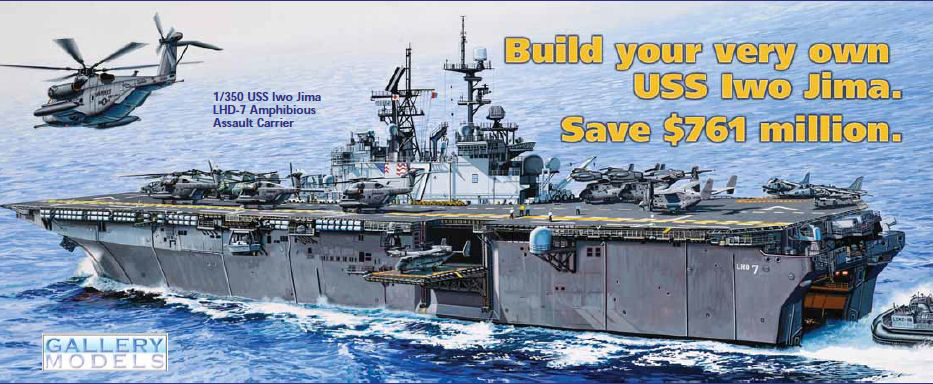
Reviewed by Martin J Quinn

| HISTORY | ||||||||||||||||||||||||||
|
USS Iwo Jima (LHD-7) is the seventh ship of the Wasp-class Landing Helicopter Dock Amphibious Assault Ships. The Wasp-class are an improvement on the earlier Tarawa class of ships. Work on Iwo Jima started in September 1996, with her keep being laid in December, 1997. Launched on February 4, 2000, she was christened on March 25, 2000. She made her maiden voyage on June 23, 2001, with over 2,000 World War II veterans onboard - many Marine veterans who had fought on Iwo Jima in 1945 - and was commissioned on June 30, 2001. On March 4, 2003, Iwo Jima left her homeport of Norfolk, Virginia, to participate in Operation Enduring Freedom. That April, she deployed Marines from her position in the Mediterranean Sea into the northern part of Iraq to participate in the conflict there. After serving as the 2nd Fleet Flagship in Norfolk in 2005, Iwo Jima was dispatched to New Orleans in August of that year, where she served as flagship for the Commander-in-Chief, George W. Bush, during Hurricane Katrina Joint Task Force disaster relief efforts. While in New Orleans, Iwo Jima served as the only fully functional air field for helicopter operations, where she conducted over a thousand flight deck operations; provided hot meals & showers, drinking water, and a place to berth for National Guardsmen and relief workers. She also provided medical services for disaster victims; and conducted clean-up operations in the areas affected by the hurricane around New Orleans. For her efforts, Iwo Jima is only the second Navy ship to have been presented the flag of the President of the United States. In 2006, Iwo Jima deployed to the US European/US Central Command area of operations, where she served as flagship for the Iwo Jima Expeditionary force. During her deployment, she assisted with the evacuation of US citizens from Lebanon in July 2006, after hostilities there left the Beirut International Airport unusable. Awarded a "Battle E" efficiency award in 2007, Iwo Jima also participated at the annual Fleet Week festivities in New York City in 2002, 2004, 2009, 2010, and 2011. In November, 2010, she was deployed to Haiti to provide humanitarian assistance to that earthquake ravaged nation as a tropical storm moved in. Most recently, in October 2011, the ship was part of training between Amphibious Squadron (PHIBRON) 8 and the 24th Marine Expeditionary Unit (MEU), which begain PHIBRON-MEU Integrated Training (PMINT). PMINT is the first integrated training between the Iwo Jima Amphibious Readiness Group (ARG) comprised of the amphibious assault ship USS Iwo Jima (LHD 7), amphibious dock-landing ship USS Gunston Hall (LSD 44) and amphibious transport dock ship USS New York (LPD 21), and approximately 2,200 Marines from the 24th MEU. History adapted from Wikipedia and Navy.Mil Iwo Jima pages. Dimensions:
As with her sister Wasp, Iwo Jima's weapons are defensive in nature; her offensive arms are her Marines and their equipment. To ensure the safety of her embarked USMC components, Iwo Jima is equipped with Sea Sparrow launchers, Mk29 21-cell Rolling Airframe Missile (RAM) launchers, Phalanx CIWS, 25mm Bushmaster cannons and numerous M2 .50 machine guns. The assault vehicles, equipment and aircraft included in the kit is comprised of:
|
||||||||||||||||||||||||||
|
The
USS Iwo Jima (LHD-7) is Gallery's follow up to the 2010 release of the
USS Wasp (LHD-1). You can find Sean Hert's review of the Wasp
here. This review is of an advanced copy
of the new kit, direct from MRC, the exclusive importer of Gallery Models into
the USA My
copy of the Iwo Jima was so new that it came in a plain white box with
photo copies of the instructions and painting guide (the latter was, thankfully,
in color). Upon removing the lid, you'll find the box packed to the top with
parts, all nicely packaged. The flight deck - which is on the bottom of the box
- is wrapped in thin white "foam" paper to protect it, and the large one piece
hull is secured with by cardboard boxes both fore and aft. The aircraft come in
a smaller box inside the larger box for further protection. |
||||||||||||||||||||||||||
|
||||||||||||||||||||||||||
| HULL PARTS - COMMON | ||||||||||||||||||||||||||
|
The Iwo Jima shares the same hull with Wasp. As such, it is molded as a large single piece hull with no waterline option. It is solidly cast, with thick plastic sides to stiffen the hull against warpage. This dimensional stability will be enhanced with the addition of the flight deck, as well was the hangar and well decks in the after half of the hull. The only parts of the main hull that are molded separately are the bulbous forefoot and bilge keels. There is no indicated waterline, and there are some additional stiffing strakes on the inside of the hull; waterlining this hull will be slightly more challenging than most. The hull has many surface details molded on. This high level of detail is well executed, and looks great. The conduits and pipes running along the hull, and the hangar and deck openings are nicely done, and are a precursor to much of the bulkhead details to be seen later in the kit. The large anchor bolsters are present, and the inset deck edge elevators are nicely done, as well as various hull openings and hatches around the hull. The bottom of the hull shows some slight mold lines, but they will be easily removed with some light sanding. The kit measures out to about 27" long at the waterline and about 28 7/8" overall, which is pretty close to the indicated 29". It's also very close in beam, about 3.5". Both the length and beam measurements are within the margin of error. This is a very large ship. In fact, it's just about the same size as a World War II Essex-class carrier. |
||||||||||||||||||||||||||
|
||||||||||||||||||||||||||
|
||||||||||||||||||||||||||
| DECK PARTS - COMMON | ||||||||||||||||||||||||||
|
There are three different decks, comprised of 4 parts in this kit. The long single piece flight/main deck is first, followed by the single piece hangar deck, which also forms the overhead of the well deck, and the 2 piece well deck/vehicle deck. The flight deck also has underside detail to form the overhead of the hangar deck. The flight deck covers almost the entire length of the ship. Covered with molded-in tie-downs, the deck is also inscribed with the locations of the deck markings. The flight deck also has many small protruding platforms, for various antenna and other uses. The cross bar parts of the tie-downs are not quite flush with the decks, but the tie-downs themselves look about the same size as a main gear wheel on the aircraft. |
||||||||||||||||||||||||||

Flight Deck |
||||||||||||||||||||||||||
|
||||||||||||||||||||||||||
|
The hangar deck is also dotted with tie downs, and has locators for the bulkheads and repair facilities. There are also notches indicating where the hangar doors to the elevators will be positioned. |
||||||||||||||||||||||||||
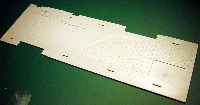
Hangar Deck |
||||||||||||||||||||||||||
|
||||||||||||||||||||||||||
|
The well deck is made up of two deck sections. A shorter upper deck section for vehicle prep with a ramp leading down to wet well deck. Each deck piece is detailed with the appropriate surfaces. |
||||||||||||||||||||||||||
|
||||||||||||||||||||||||||
|
||||||||||||||||||||||||||
| SPRUE A - COMMON | ||||||||||||||||||||||||||
|
Sprue A is one of the larger sprues in this Wasp kit, with a great variety of parts on it. From the two aircraft elevators to the props, shaft and rudders are all here. Both of the ship's boats are also here, as well as many smaller detail parts like radars, platforms and antenna. |
||||||||||||||||||||||||||
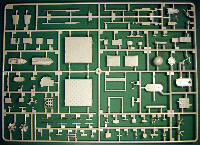 |
||||||||||||||||||||||||||
|
||||||||||||||||||||||||||
| SPRUE B x2 - COMMON | ||||||||||||||||||||||||||
|
B is also a large sprue, but in this case is mainly concerned with the large number of life raft capsules that will surround the edges of the flight deck. As Wasp class ships not only have a large compliment, but can also carry up to 2,000 United State Marines, a large number of capsules would be required in case of loss. One of the ships large anchors, and some impressive looking winches are also present. |
||||||||||||||||||||||||||
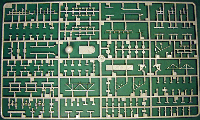 |
||||||||||||||||||||||||||
|
||||||||||||||||||||||||||
| SPRUE C x2 - COMMON | ||||||||||||||||||||||||||
|
Sprue C has a mix of weapons on it, some of which are impressive little models themselves. The Phalanx CIWS, RAM launcher and Sea Sparrow launchers all look to be highly detailed and impressive parts. The various RBOC launchers and ECM antenna are also a nice touch. The .50 BMG and 25mm Bushmaster Mk 38 guns for close range self defense leave a bit to be desired however. |
||||||||||||||||||||||||||
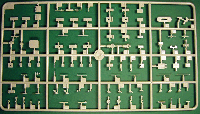 |
||||||||||||||||||||||||||
|
||||||||||||||||||||||||||
| SPRUES D - COMMON | ||||||||||||||||||||||||||
|
This is a simple sprue, with railings, walkways and the bilge keels. |
||||||||||||||||||||||||||
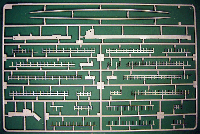 |
||||||||||||||||||||||||||
|
||||||||||||||||||||||||||
| SPRUE E - COMMON | ||||||||||||||||||||||||||
|
This sprue continues with the deck edge walkways of sprue D. All the walkways have detail on the underside as well, simulating girders and other supports. |
||||||||||||||||||||||||||
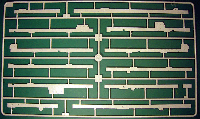 |
||||||||||||||||||||||||||
|
||||||||||||||||||||||||||
| SPRUE F - COMMON | ||||||||||||||||||||||||||
|
Sprue F has the main bulkheads of the well deck, and the bulbous bow extention missing from the hull. The well deck has nice detail, with a continuation of the wooden pads seen on the earlier well deck parts. The walkways above the well are molded with watertight doors, conduit and other details, but the prominent battle lights and fluorescent lights of the well deck are missing. Also missing are some cranes and other lift equipment for the overhead of the well deck, as well as railings for the walkways. That being said, the details that are present are crisp and fine. |
||||||||||||||||||||||||||
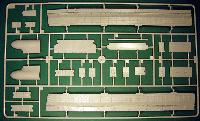 |
||||||||||||||||||||||||||
|
||||||||||||||||||||||||||
| SPRUE G - COMMON | ||||||||||||||||||||||||||
|
Sprue G has bulkheads for the upper well deck, as well as some of the hangar deck. |
||||||||||||||||||||||||||
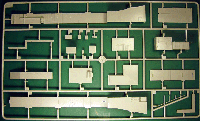 |
||||||||||||||||||||||||||
|
||||||||||||||||||||||||||
| SPRUE H - COMMON | ||||||||||||||||||||||||||
|
H is mostly bulkheads and other parts for detailing the hangar deck. The nice bulkhead details, like the watertight doors and conduits, really stand out here. Some of the conduits running along the bulkheads are hair-thin. |
||||||||||||||||||||||||||
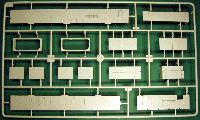 |
||||||||||||||||||||||||||
|
||||||||||||||||||||||||||
| SPRUE L - IWO JIMA ONLY | ||||||||||||||||||||||||||
|
Sprue L is made up of large flat structures; mostly the bulkheads needed to make the monolithic superstucture/bridge atop the flight deck. There is also the small deck for the fantail and after Sea Sparrow mount. |
||||||||||||||||||||||||||
|
|
||||||||||||||||||||||||||
|
||||||||||||||||||||||||||
| SPRUE M - IWO JIMA ONLY | ||||||||||||||||||||||||||
|
Sprue M has many small detail parts. Many of these parts are various antennas for the superstructure/bridge. Also like sprue A, parts for one of the two exhaust stacks are also here, some various platforms and lattice structures as well as the name plate (which was a stand alone part on Wasp). |
||||||||||||||||||||||||||
|
|
||||||||||||||||||||||||||
|
||||||||||||||||||||||||||
| SPRUE N - IWO JIMA ONLY | ||||||||||||||||||||||||||
| Sprue N contains small parts for the island - platforms, masts, lattice supports for the mast and various other smaller parts.. | ||||||||||||||||||||||||||
|
||||||||||||||||||||||||||
| SPRUE P - IWO JIMA ONLY | ||||||||||||||||||||||||||
| Sprue P contains catwalks/platforms and support structures that run along the sides of the hull. | ||||||||||||||||||||||||||
|
||||||||||||||||||||||||||
| WA x2 - COMMON | ||||||||||||||||||||||||||
|
Sprue WA is the tractors, Tilly cranes and other vehicles at service the Iwo's air wing. There are 2 types of forklifts, tow tractors, fire fighting trucks and even the NAN-2 Nitrogen servicing unit for airing up tires! |
||||||||||||||||||||||||||
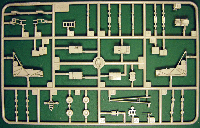
Deck Vehicles |
||||||||||||||||||||||||||
|
||||||||||||||||||||||||||
| ASSAULT VEHICLES AND AIRCRAFT - COMMON | ||||||||||||||||||||||||||
|
This kit comes supplied with a large variety of vehicles, aircraft and equipment. From tanks and amphibious assault vehicles, to the aircraft complement and the landing craft needed to get Iwo Jima's combat vehicles and Marines ashore, this kit has them. While the Wasp contains a sprue for SH-60K helicopters, this kit has a sprue (x2) for a SH-60F. I have seen comments that this class doesn't normally carry SH-60 choppers on board (and that the K model is used only by the Japanese), so I am not sure in the inclusion of the F model is more accurate then not including these aircraft at all. To simplify the layout of this review, a link to Wasp's accessories (which are almost exactly the same as Iwo Jima's) have been listed on separate pages. | ||||||||||||||||||||||||||
| PHOTOETCH | ||||||||||||||||||||||||||
|
Iwo Jima comes with 3 photoetch frets, labeled ETCH A and ETCH B (x2). These frets include some optional brass parts, like railings and ladders, to upgrade the plastic ones in the kit. The instructions call out when these optional pieces can be used. Not many kits include a full set of photoetch railings, so this is a nice touch. Be forewarned, these railings are not pre-shaped, and proper use will require some research by the builder. ETCH A is unique to Iwo Jima, and larger and more extensive than the ETCH A that was included with Wasp. ETCH B is identical. |
||||||||||||||||||||||||||

Fret A |
||||||||||||||||||||||||||
|
||||||||||||||||||||||||||

Fret B |
||||||||||||||||||||||||||
| ||||||||||||||||||||||||||
| DISPLAY BASE OPTIONS | ||||||||||||||||||||||||||
| The standard display base is included. |
 |
|||||||||||||||||||||||||
| DECAL | ||||||||||||||||||||||||||
|
There are 3 sheets of decals included in Iwo Jima; 1 of deck markings for Iwo herself, one for the LCAC's (plus an additional decal for the island), and a combined sheet for all the included airwing. The markings for the CH-46's include letter that appears to be "MQ". It was nice of Gallery to personalize the airwing for me! One omission: Iwo Jima has her motto - "Uncommon Valor Was a Common Virture" - displayed on the starboard side of the island. Beneath that are the words "Why we are Here", with a list of the casualties from the Iwo Jima campaign and terror attacks, going back to the Beirut Marine barracks bombing, listed. Being that these are a distinctive part of the ship, it would have been nice if these had been included in the decal sheet. |
||||||||||||||||||||||||||
|
||||||||||||||||||||||||||
| INSTRUCTIONS | ||||||||||||||||||||||||||
|
A 36 page instruction book is included, using familiar construction order and methods. The only real options the modeler needs to decide upon during the build is whether to have the hangar doors and well deck door positioned opened or closed. Presumably, if you build the hangar doors both closed, you can skip the rest of the hangar construction and painting. The same goes for the well deck. One thing missing is some indications for the proper stowage or securing the LCU's or LCAC's aboard Iwo Jima. Additionally, there are limited color callouts during the construction process - most color info is on the color poster. One thing that may affect some builder's styles- some steps show the ship inverted, bottom up, for application of some parts to the underside of the walkways and platforms around the flight deck. For my pre-production sample, two full color posters showing the painting steps for Iwo Jima and all the on-board craft are included. I'm guessing for the production release, a full color double-sided poster, as was included with Wasp, will be the norm. Mr. Hobby, Vallejo, Model Master, Tamiya and Humbrol colors are shown on a paint reference chart. Some of the camo choices for the USMC vehicles are questionable, and the modeler should research appropriate camo schemes for the vehicles and time period being modeled. |
||||||||||||||||||||||||||
|
||||||||||||||||||||||||||
|
||||||||||||||||||||||||||
| CONCLUSIONS | ||||||||||||||||||||||||||

Overall, the USS Iwo Jima is very impressive. The box is loaded with parts (over 1,400!), the moldings are really nicely done and you get plenty of accessories to trick out your Gator Freighter. With the inclusion of four new, Iwo Jima specific sprues (L, M, N and P), it appears that Gallery has done their homework to give you kit that captures the differences between her and the earlier Wasp release. This is not a case of throwing new decals in the same box and calling it "new". Other highlights: My verdict: Highly Recommended! Thanks to MRC for the pre-release review sample. Gallery Models is exclusively imported into the USA by MRC. This kit should be showing up in your local hobby shops soon (November 2011). It is kit #64002 and retail price is $259.98. |
||||||||||||||||||||||||||
